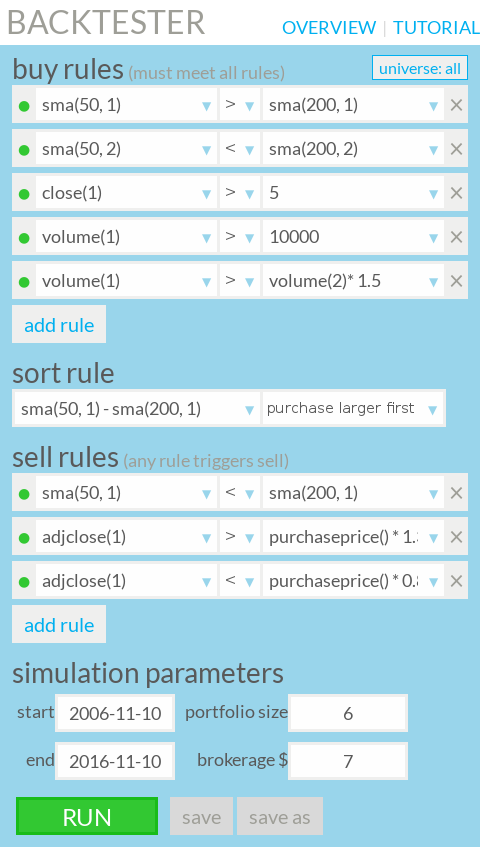Picking up where we left off
In my previous blog post, I examined the bare bones of the Golden Cross to see if it held up as a profitable trading strategy. Long story short - absolutely not! However, it wouldn't have such an illustrious and ostentatious name if there wasn't some wisdom in its rules.
To review, the Golden Cross says to trade according to the following rules:
- buy a stock when its 50-day average price crosses above its 200-day average.
- sell the stock when its 50-day average price crosses below its 200-day average.
At the very end of the post, I suggested the Golden Cross may be a good starting point, and not the end-all solution for a profitable trading strategy. I had some ideas about what might improve the strategy, so let's see what works!
Adding a few more rules
One of the biggest failures of the plain Golden Cross strategy is no safeguards against purchasing flat-out risky stocks.
- Add
close(1) > 5as a buy rule to weed out penny stocks.
You might remember from the previous post that the Golden Cross could be supported by high trading volumes. This makes sense because higher volume means there is more immediate momentum that's pushing the stock price higher, implying the 50-day crossing the 200-day average is not being caused by the background noise in all stock price movement.
- Add
volume(1) > volume(2) * 1.5as a buy rule. This says the most recent day's trading volume must be at least 50% greater than the day before, which is a pretty huge jump in volume! When combined with the 50/200 day crossover, we have quite the powerful storm of upward price momentum. - Add
volume(1) > 10000as a buy rule. Stocks with low volume might frequently experience 50% volume spikes, which is hardly an indicator of market support. After all, going from 100 shares traded to 150 shares isn't very much. However, going from 10 billion shares to 15 billion shares is definitely a lot, and says many people are excited about buying!
Next, let's try to be smarter about selling. When the 50-day crosses below the 200-day average, also known as the Death Cross, the actual price of the stock has probably already sunk much lower.
- Add
adjclose(1) > purchaseprice() * 1.3as a sell rule to take gains before they fall. - Add
adjclose(1) < purchaseprice() * .88as a sell rule to cut our losses short. You might recognise this as a 12% stop loss.
I used the sort rule sma(50,1) - sma(200,1) with purchase larger first in the original Golden Cross example, and I will continue to use it here. This prefers stocks that have a wider crossover, which means it is showing a stronger Golden Cross pattern.

Results

Yes! We've completely turned the Golden Cross around! With a few more rules, we were able to turn a sorely losing strategy into a pretty darn good one. We beat the market handily, and missed the worst of the 2008 downturn.
Always more to explore
When I see results like this, I can't help but think about other ways I could tweak the strategy to make it even more resilient and profitable. After all, this article examined only one of the ideas I had for improving the Golden Cross in my previous blog post. I'm still eager to pair it with fundamental analysis techniques so I can hopefully avoid the drawdown this strategy experienced in 2015.
Still, the biggest take-away for me is that we can start with an age-old strategy that may have lost its luster, and quickly turn it back into a profitable strategy tuned for modern markets. All we needed to do is ask the question, and then start testing!